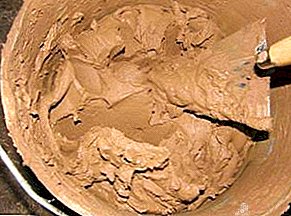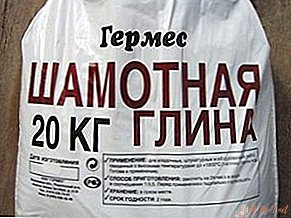 During construction, an important role is played not only by the project and work plan, but also by the choice of materials. Often it depends more on how much the design is durable and reliable. Most of the requirements are for those materials whose use is expected to be used under conditions far from normal: be it strong winds, frosts or high temperatures and humidity. Fireclay clay belongs to the category of materials, which is a way to maintain their properties under extreme operating conditions, for example, in furnaces.
During construction, an important role is played not only by the project and work plan, but also by the choice of materials. Often it depends more on how much the design is durable and reliable. Most of the requirements are for those materials whose use is expected to be used under conditions far from normal: be it strong winds, frosts or high temperatures and humidity. Fireclay clay belongs to the category of materials, which is a way to maintain their properties under extreme operating conditions, for example, in furnaces.
What is fireclay clay
 Fireclay clay is in essence burnt kaolin, which is usually called fireclay. Kaolin is a type of rock that has high viscosity and ductility. In addition to the main element, it can contain impurities in the form of oxides of potassium, calcium, magnesium and sodium, hydroxides of iron and titanium, as well as numerous sulfides.
Fireclay clay is in essence burnt kaolin, which is usually called fireclay. Kaolin is a type of rock that has high viscosity and ductility. In addition to the main element, it can contain impurities in the form of oxides of potassium, calcium, magnesium and sodium, hydroxides of iron and titanium, as well as numerous sulfides.
Kaolin for use is fired at temperatures of about 1500 degrees Celsius, which allows you to save the mineral from the content of unbound water. This procedure, in fact, gives ready-made fireclay. Impurities are removed both during the firing process and during further enrichment.
Heating kaolin to such high temperatures reduces the chamotte ductility at the outlet, but at the same time it acquires its main feature - high refractoriness. Such chamotte is subsequently crushed for further use both to a dispersed state (sand) and to small pieces (crushed stone)
According to the processing technology, chamotte is divided into two types:
- highly valued;
- low annealed.
Between themselves, they differ in percentage of water absorption: it is lower at higher annealing temperatures.
How to breed fireclay clay for the furnace
Preparing a solution of chamotte is considered a difficult task, so it is important to carefully approach this matter, since a properly prepared mixture is the key to a reliable and durable construction.
IMPORTANT! It is worth thinking about the preparation of the mixture in advance, since it is necessary to pre-soak the clay for several days.
Cooking steps
In order for the resulting chamotte solution to have all the declared positive qualities, it is necessary to strictly observe all the rules for its preparation. To do this, you should adhere to the following algorithm of actions:
- Clay is poured into a container in which mixing will be carried out.
- An admixture is laid out on top: chamotte or quartz sand. They should be proportionally larger than crushed clay 2-5 times.

- On top of the dry mixture is poured with water.
- Everything is mixed with a spatula, a construction mixer or a drill with a special nozzle until a homogeneous mass is obtained.
- The container is tightly closed and left for three days. It is necessary to close it so that the liquid does not leave the container.
- At the end of the soaking period, the mixture is thoroughly mixed again, after which you can already begin to work.
REFERENCE! Fireclay sand is required less than quartz.
If you neglect the correct preparation of the solution, then at the exit you can get indigestible mass, which is unlikely to be suitable for any construction work. In order not to translate the material in vain, strictly follow the specified algorithm - this will allow you to get a solution that will last a long time in your masonry oven.
What to do if the clay solution has dried up or an unsuitable consistency has turned out
Unfortunately, such incidents, when a solution of the wrong consistency is obtained, cannot be avoided even by a professional laying man. The proportions of gravel, sand and water are often selected by eye, and when the clay swells for three days, its condition can change in different ways: due to differences in temperature, humidity and similar nuances, which are difficult to influence in non-laboratory conditions.
The ideal consistency of diluted chamotte clay should resemble thick sour cream and not suggest the presence of lumps. If the solution does not satisfy this requirement, then you should analyze the situation and come to the appropriate decision.
If there is a lack of moisture, add water. The presence of a sufficient amount of water directly affects the plasticity of the mixture and its adhesion. With a low moisture content, the mixture will be poorly applied and crack.
If the solution is too liquid, add sand to it. At the same time, there is no need to leave the mixture for a few more days.
IMPORTANT! Do not prepare clay solution in large quantities. If you plan to work for several days, then instead of daily dilution of the mixture, you should give preference to portioned blanks made with a temporary run.
Advantages and disadvantages of fireclay clay
Chamotte clay for plaster has gained its popularity for a reason. Its advantages:
- Durability. With proper use, chamotte clay does not deteriorate for a relatively long time.
- High adhesion. This quality allows the clay to adhere perfectly to almost any surface with which it is in contact.

- Vapor permeability. This material will not dampen over time due to the concentration of moisture near it.
- High fire resistance. It can be used in furnaces and in similar conditions, unsuitable for other materials.
- Safety and environmental friendliness. Clay is free from toxins, and its origin is natural.
- Excellent layout with fireclay bricks due to the same coefficient of linear expansion.
- Uniformity during heating. The expansion of the material with increasing temperature occurs gradually, it eliminates the appearance of cracks.
She is not without flaws. Like all materials, chamotte is excellent for use in some conditions, and behaves badly in others. The main negative qualities of fireclay clay are usually attributed to:
- high cost;
- difficult preparation of the correct solution.
The first drawback can be rethought by comparing the properties of chamotte clay with other binders, and by the price-quality ratio already come to a final solution. The second is simply solved by a clear sequence of actions when mixing the solution.



Leave Your Comment